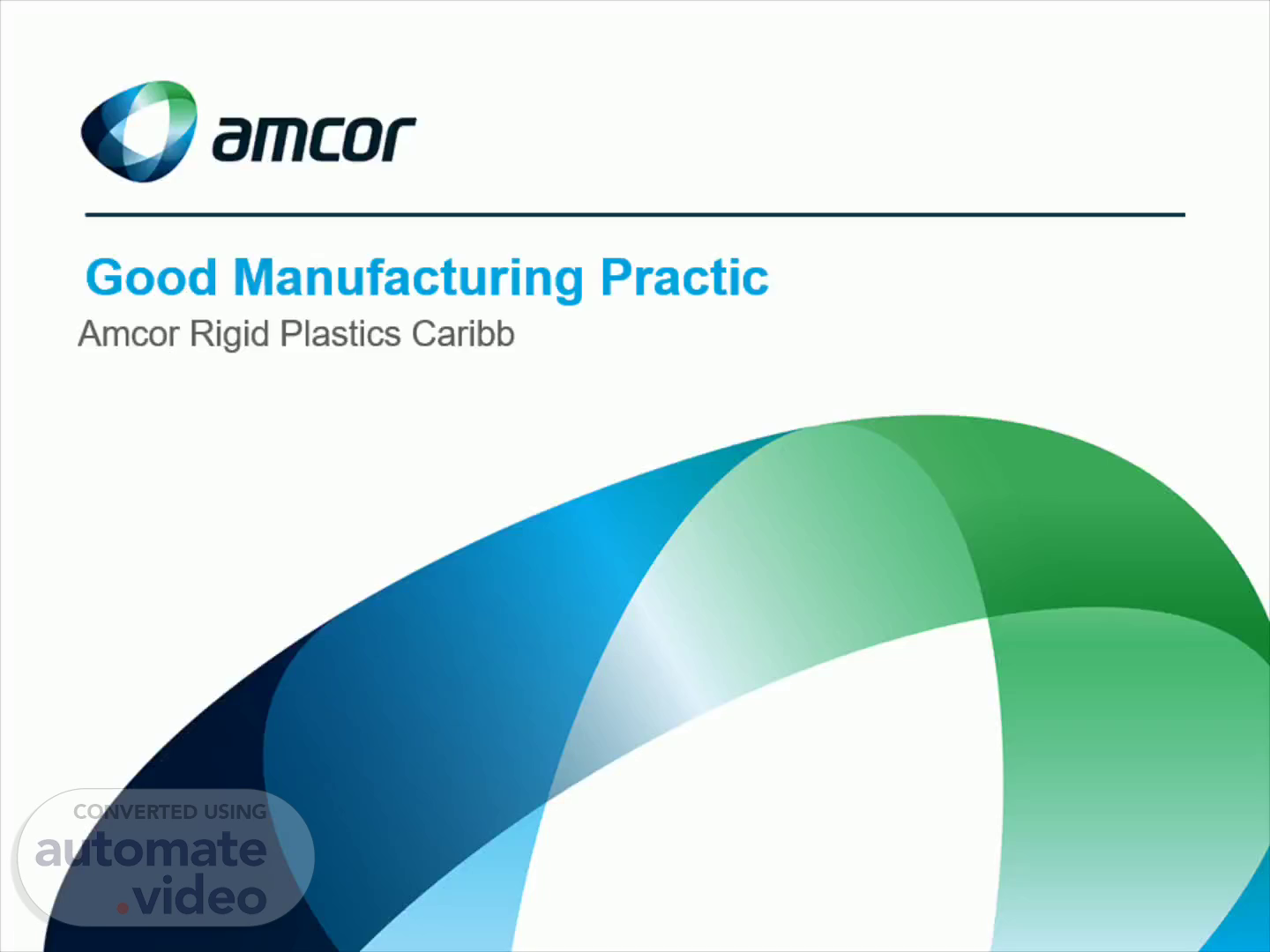
Page 1 (0s)
Good Manufacturing Practices. Amcor Rigid Plastics Caribbean Ltd..
Page 2 (7s)
OBJECTIVES. To become aware of Good Manufacturing Practices To learn methods to prevent cross contamination To know the 5S principles To learn the proper methods of handling packaging materials To understand pest control & prevention To learn about allergens To learn proper Chemical Storage & Handling Techniques To understand Food defense.
Page 3 (23s)
GOOD MANUFACTURING PRACTICES. Good Manufacturing Practices are a collection of recognized rules, procedures and practices that together provide guidelines stating what is and what is not acceptable. It is preventive in its approach and aims to ensure that our quality and food safety objectives are met consistently..
Page 4 (39s)
PERSONAL HYGIENE. Shower and brush teeth before coming to work Use deodorant (Note: no strong perfumes are allowed) Hair must be clean Clothing must be clean, not torn & changed daily Fingernails must be short & clean Fake nails & nail polish are not allowed No fake eyelashes No makeup.
Page 5 (55s)
ADORNMENTS. Remove all earrings (including tongue, eyebrow & nose rings), rings, watches, plastic bands, chains before entering the factory.
Page 6 (1m 6s)
RESTRICTIONS. All pens in use must not have covers Do not place pens behind ears Do not use headphones Place all badges below waist level Do not enter into the plant with food (including mints & gum) No glass or brittle materials are allowed in the processing area No spitting, no urinating or defecating allowed. Do not enter into the plant if you display signs of food poisoning symptoms or if you are sneezing/coughing excessively. Do not work if you have an exposed cut or wound.
Page 7 (1m 31s)
HANDWASHING. HAND WASHING MUST BE DONE: Before entering the factory After using the bathrooms After any chemical usage After smoking After hands have become soiled/ contaminated.
Page 8 (1m 42s)
HANDWASHING STEPS. Wet hands Lather with soap for at least 20 seconds Rinse thoroughly Dry completely Sanitize.
Page 9 (1m 52s)
DISPOSABLE GLOVES. Use gloves when handling preforms & raw materials Change gloves when torn or when they have become contaminated Dispose of gloves in bin when leaving the processing area.
Page 10 (2m 4s)
HAIR RESTRAINTS. Hair nets must be worn before entering into the plant Hair nets must cover ears and retain all hair strands Once not clean shaven, beard nets must be worn Beard nets must cover side burns and moustache. Do not enter into bathrooms with hair or beard nets Do not leave the compound with hair or beard nets.
Page 11 (2m 22s)
WEARING OF MASKS. 11. Masks must be worn at all times Ensure mask is on before entering into the reception area Mask must cover nose and mouth.
Page 12 (2m 34s)
CROSS CONTAMINATION. Prevent cross contamination: Account for all tools before and after use Ensure all machinery parts are in place after a maintenance job Clean machine thoroughly after a change over Clean machine and work area daily to ensure it is free of excessive grease, oils & lubricants Report any equipment that is rusty, cracked or broken. Use Wypal for cleaning.
Page 13 (2m 52s)
5S. 13. 5S- Know it, Promote it, Practice It .. NiMi-sns I-as xuos sæzs.
Page 14 (3m 1s)
HANDLING OF PACKAGING MATERIAL. 14. Packaging materials must be clean and in good condition DO NOT allow packaging material that comes into contact with the product to touch floor or any packaging contact surface Plastic bags for the inside of the boxes must NOT be deployed until time to be filled Keep finished products covered at all times.
Page 15 (3m 18s)
PEST CONTROL. PEST CONTROL. 15.
Page 16 (3m 25s)
D animals anim0246 wmf. PEST CONTROL. 16. PEST PREVENTION Good Housekeeping Practices : Clean all spills immediately; keep all waste disposal containers covered. Proper Storage Practices : All items must be stored 18 inches away from the wall and 6 inches off the floor. Report all pest in a pest sighting log.
Page 17 (3m 44s)
DEFINITION:. ALLERGENS. 17.
Page 18 (3m 52s)
ALLERGENS. 18. Soybeans Peanuts Shellfish TOP 8 FOOD ALLERGENS Fish Tree Nuts Eggs Wheat.
Page 19 (3m 58s)
CHEMICAL MANAGEMENT. Safety data sheets must be available for all chemicals at locations where they are used. Chemicals must be stored in their designated locations All chemicals must be secured under lock and key when not in use Cover chemicals after use Chemicals must be labelled with its name and the NFPA chemical diamond.
Page 20 (4m 16s)
BIOVIGILANCE. 20. Also referred to as bioterrorism or food defense . Defined as the security of food and drink products and their supply chains from all forms of malicious attacks leading to contamination or supply failure . Food defense differs from food safety because it involves efforts to prevent intentional contamination of food products by biological, chemical and physical agents that are not likely to occur in the food chain. Your Responsibility : Report any suspicious activity..
Page 21 (4m 37s)
21. THE END.